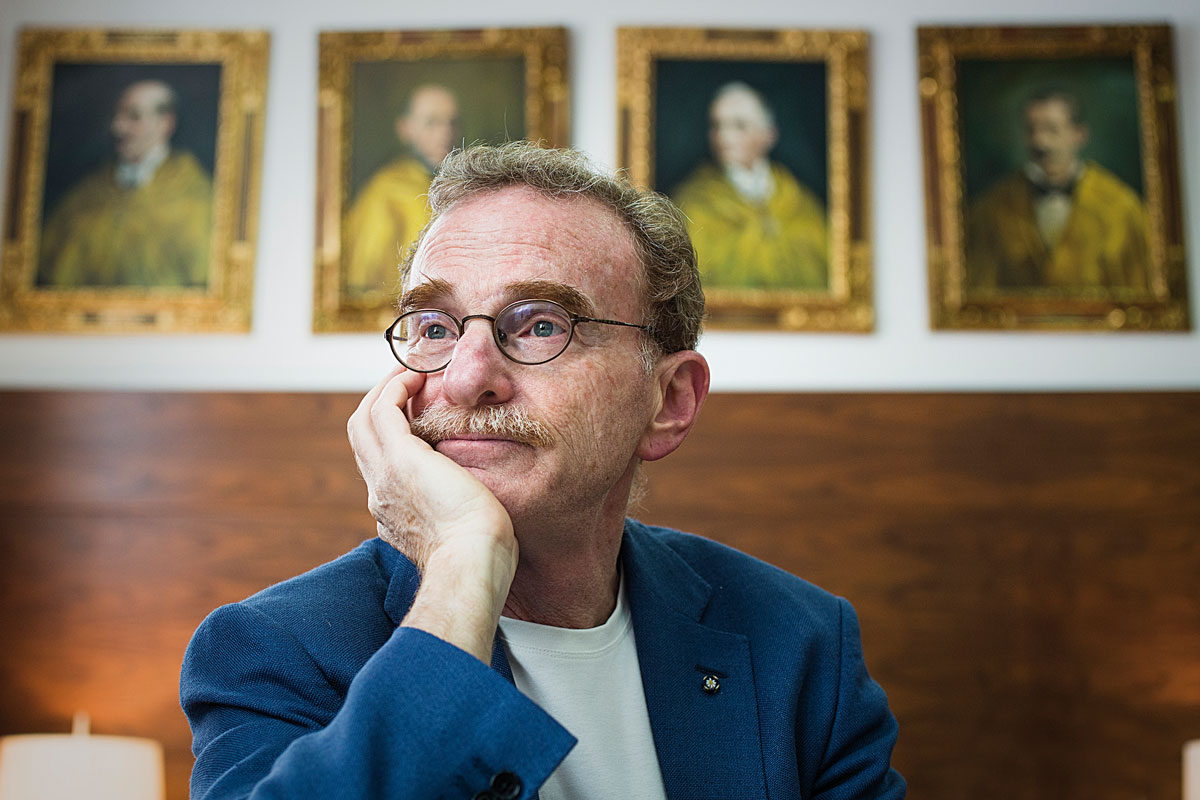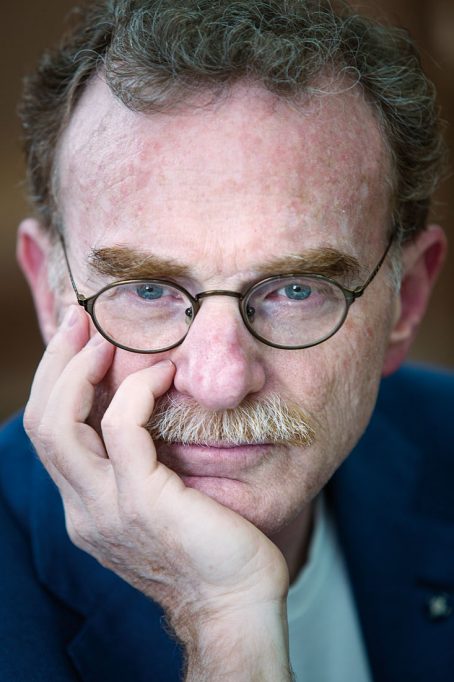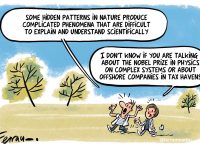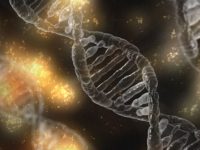Interview with Randy Schekman
«Journals like Nature, Science or Cell prey on people's vanity»
Cell biologist. Nobel Prize for Medicine 2013

Cell biologist, in 2013 he won –together with the biology researchers James Rothman and Thomas Südhof– the Nobel Prize for Medicine, for a breakthrough regarding the regulation of vesicular traffic. This is a fundamental mechanism for the correct communication of a cell. In fact, defective vesicular traffic is related with diseases such as diabetes. From his lab at the University of California, Berkeley, he continues his work with this essential mean of cell transport.
But Randy Schekman (Saint Paul, Minnesota, 1948) is not only know due to the importance of his discoveries. Several months ago he captured the media attention when he openly criticised the most prominent scientific journals, Nature, Science and Cell. These luxurious journals, the biologist claims, focus more on selling subscriptions than on promoting important research. His critique also targets an assessment method for scientific research which is based on impact factor (the number of citations of the text during the last two years). Accordingly, Schekman was one of the first signatories of the DORA San Francisco (Declaration on Research Assessment) in 2012, an initiative championed by scientists and research institutions from all around the world demanding a change in the research assessment method.
«I said this about impact factor when I was the editor of the PNAS for five years, and I was never interviewed by the press about my position then. But I won a Nobel Prize and now I have a louder voice»
Randy Schekman attended a meeting with students and professors of the University of Valencia, in the context of the Excellency Meetings VLC/CAMPUS and his participation as jury of the Rei Jaume I awards. After an hour answering the questions of the public, we talked to him. We explained that in Mètode, we started the Two Cultures Observatory, devoted to the relationship between scientists and the media, so we were very interested in his opinions in this regard. Despite his affable look and permanent smile, Randy Schekman’s discourse comes out convincing and profoundly critical.
You defend that scientific publications such as Nature, Cell or Science distort the reality of scientific research. But these journals are still the most respected in the scientific community.
Yeah, they have a very effective business plan, I would say. They prey on people’s vanity. People like to be part of an exclusive club. And so they encourage this, by being very selective in what they choose to review. They look for things they think would be very hot, you know, big sellers. And then, even after they agree to review a paper, they impose increasing demands on the author to do new things, to somehow make it even more perfect. They ask a large number of people, and they go back to them over and over again, sometimes it takes much more than a year, and then finally sometimes they decide to reject the paper after all. And this creates an enormous effort and added expense before the paper gets published, which I think is another toxic influence. It causes delay in the publication of science.
You have announced that you will not publish in those journals, but you have a prestige.
Well, ok. I’ve been saying this for a long time. I actually haven’t published my own primary research in those journals for some years. And I said this about impact factor when I was the editor of the Proceedings of the National Academy of Sciences for five years, and I was never interviewed by the press about my position then. But I won a Nobel Prize and now I have a louder voice. And I intend to use that voice to express my voice.
But would it be as easy for researchers who are just starting to refuse to publish in these journals?
Yes, they just have to have the courage of their conviction. There are young scholars who completely avoided publishing. We have a young scholar at Berkeley, Michael Eisen, who is an expert in genome analysis, and he was one of the original editors of the PLOS journals. And he’s taken a very strong position against what he calls the «glamor journals», the «glamor magazines», and he’s never published in them. And nonetheless he’s had a very successful career, he’s become an investigator at the Howard Hughes Medical Institute. He’s very bright, and he’s very successful and he has realized that one doesn’t need to play that game in order to publish important work.

Photo: Miguel Lorenzo
Is he supported in that by the institution?
Yes, absolutely, absolutely. In fact, at Berkeley, because of his position, because of my position, more and more of my colleagues are submitting their papers to open-access journals. Of course they’re still publishing also in Cell, Nature and Science, but I think more and more at Berkeley we are finding that discussions about «oh, he published so and so in certain journals» is giving way to actually evaluating the scholarship.
In open-access journals, the author must pay to publish.
Do you think that’s a conflict of interest?
I mean, maybe it can be a different kind of bias, leaving out groups with lower budgets.
Yes, well, but you know, it costs to publish in many commercial journals too. Whereas in eLife [the open-access journal he directs], actually, we don’t charge anything. It’s completely subsidized, for the time being.
But that’s not the most common way.
No, it’s not. But I think we have an advantage, and I intend to exploit that advantage.
Some months ago, John Bohannon, journalist at Science journal, sent a fake paper, full of mistakes, to more than 300 open-access journals and 104 accepted it.
All open-access journals, yes… He might have sent it to all the commercial journals as well…
Are open-access journals less rigorous?
It’s not a question of whether they’re open-access or not. That’s a false distinction. There are other journals that are commercial or run by scientific societies that also have low standards. And I don’t think that just because a journal is open-access, that makes them somehow more suspicious. It’s true, there are businesses out there, they are looking to exploit the open-access movement to make money, and the buyer must be aware. As I said earlier, if you want to publish in one of these new journals, look at the composition of the editorial board and see who’s actually putting their time in to make it a successful venture. And that should be the deciding factor.
Is it sustainable to have so many scientific publications? Is it a bubble that could burst any moment?
Before the open-access movement there were thousands of titles. There were many journals. Now, it is tough to survive, because libraries have budget cuts and they look very carefully at what they’re subscribing to, or what they’re getting licenses for, and so I think there could be a lot of journals that die, and maybe that’s a good thing.
«I don’t think that just because a journal is open-access, that makes them somehow more suspicious»
Which is the role of the Internet in the increasing number of journals?
Oh, it’s crucial. I mean, it is a complete change in the way that we read things. Most young scholars don’t even look at a journal anymore. A hard copy of a journal is a dinosaur. And the only reason that Nature and Science continue to flourish is people wanting the magazine to read the front matter. You know, the publication in these journals are often just in the back pages. People read the science news, not so much the papers. It’s actually a very unpleasant experience to read a Nature paper, or to read a science paper.
Really?
Yes, because it’s a tiny little advertisement of the paper. Most papers in Science now, the bulk of the paper is relegated to the supplementary section, which is online and not in print. When you submit the paper to Nature or Science it’s often a full paper, and if you struggle and you get it accepted they usually tell you to cut out most of the stuff, and put it in the supplement. And again, it’s because their model is a print version and they’re trying to save money on the print, which for me it’s a completely artificial commodity in the twenty-first century. They should not be doing this. Papers should all be online in the full form so that people can read them.
A great deal of papers are not read, and many experiments are not replicated. Without confirmation and the subsequent debate, where does all this knowledge go?
We have a problem. Some people claim that important papers cannot be replicated. I think this is an argument that has been made by the drug companies. They claim that they take observations in the literature and they can’t reproduce them, but what I wonder is whether they’re really reproducing the experiments or simply trying to develop a drug in an animal model and not exactly repeating the experiments in the publication. But I think it is unknown what fraction of the literature is wrong, so we’re conducting an experiment. We’ve been approached by an organization called the Reproducibility Project, where a private foundation has agreed to provide funds for experiments in the fifty most highly cited papers in cancer biology to be reproduced, and the work will be contracted out to laboratories for replication. And we’ve agreed to handle this and eventually to publish the replication studies, so we’ll see, you know, at least with these fifty papers. How many of them really have reproducibility. The reproducibility studies will be published in eLife. We’re just getting going in that, so it may be a couple of years, but that’s what we’d like to do.
In Mètode we started the Two Cultures Observatory in order to analise the relationship between science and the media. Do you think that science publications set the agenda for the general media??
Yeah, here’s the problem that’s developed over the years. There used many more science journalists hired by newspapers, who would look at the publications in various journals. But increasingly, unfortunately, these newspapers have fired, gotten rid of their science journalists. So now many newspapers are dependent on the press releases issued by the journals to describe their work, and that may be good for the journals, but I don’t think it’s good for the general public.

Photo: Miguel Lorenzo
The number of papers has increased a lot. How can a journalist find what is really interested without being influenced by the journals or the research groups?
Well, that’s tough, that’s tough. That’s why it’s important to have science journalists working in newspapers who have the time to go and read the literature. I agree, it’s a daunting task, though.
Some scientists consider that journalists are too sensational, but can sometimes the research be exaggerated by the scientists themselves?
Oh absolutely. In order to get their papers published in Nature or Science, they exaggerate the importance of their work, absolutely. Investigators are under pressure to get their work funded and so they think that if they have more publicity for their work, even in the newspapers, that will help them with funding, or help them with recognition, fame and glory. I mean, why should scientists be any different than other people?
And what do you think about media coverage of cell biology?
It doesn’t get that much attention. Science journalists tend to focus on disease things, or discoveries like planets in other solar systems. I find, unfortunately, that most science articles in newspapers are unsatisfying to me, even in something like The New York Times. Because let’s say a newspaper journalist will talk about a drug discovery for cancer. Something that would interest me. But usually they don’t talk anything about how the drug works, and I find that very discouraging, because that’s really what I care about, that’s what the science is. But I guess they feel that for most people, most readers, that would be too much information.
«Papers should all be online in the full form so that people can read them»
Could you explain in layman terms, if possible, the importance of vesicle traffic in our cells?
Sure. So, our genome encodes around 23,000 genes. That means that our cells manufacture at least that number of protein molecules. Proteins are the molecules that catalyze the chemistry of life, they are all the little machines in our cells that make it grow and divide. And all the proteins in the cell are manufactured inside the cell, but some of them have to be shipped outside of the cell, like insulin or growth factors, all the proteins in your blood. Since there’s a barrier – the cell is surrounded by a membrane – and proteins like insulin, which are water-loving molecules, can’t just swim through the membrane, which is a water-hating barrier that doesn’t allow soluble proteins to just go through. So proteins that are going to be worked outside of the cell – antibody molecules, etc. – have to be encapsulated inside the cell by little carriers called vesicles. And these carriers convey proteins like insulin up to the cell surface and then the capsule, which is itself a membrane, surrounds the molecules like insulin inside, and this carrier merges with the membrane surrounding the cell by a process called «membrane fusion». When that happens, the inside from the capsule becomes the outside of the cell, it opens up and this special compartment, then, it’s spilled to the outside of the cell. And that’s called «secretion» and cells execute that pathway of secretion by this «vesicular traffic». And it’s responsible for all secretion of all cells and not only of protein molecules but also in the brain neurotransmitters are secreted by the same pathway. What we discovered is that yeast cells use the same thing for a yeast cell to grow, and we devised a genetic approach that isolated and identified the genes that organize that process and it turns out those genes are the same in humans. The very same genes that work to allow a yeast cell to secrete its proteins are the genes in the human genome that allow it to secrete or to transport neurotransmitters.
How did your life change after the Nobel Prize?
Well, I get interviewed by the press much more. I travel a bit more… People listen to me somehow more than they used to. Unfortunately, now the downside is that I have less time to spend with my lab. That’s the downside, that I have less time for my lab, and my life is much more hectic. And I hope it will return to some normalcy at some point, maybe after a year.





